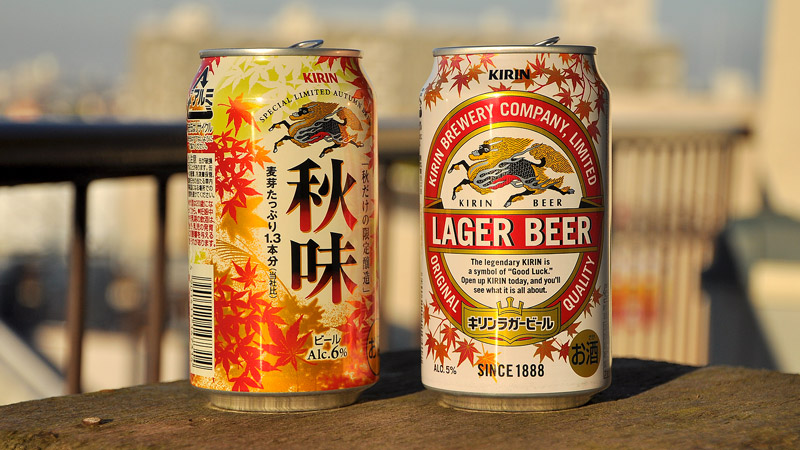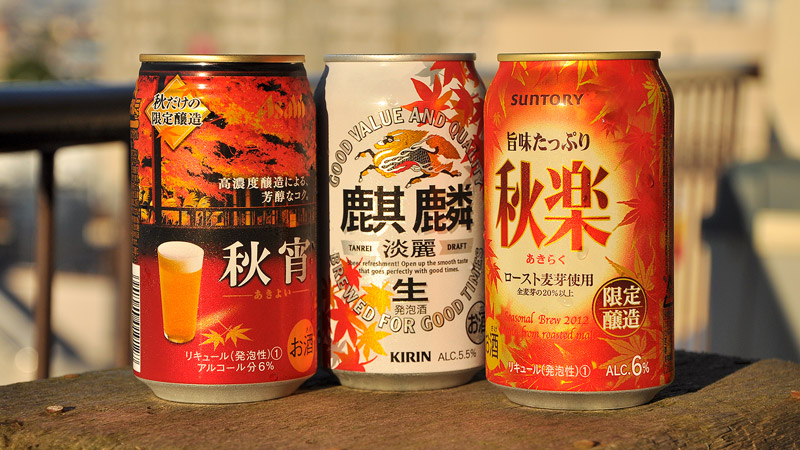This is a glimpse into how beer and “beer” companies cash in on the pre-winter, last-minute rush to enjoy the weather in one of the most gorgeous seasons of the year.
One of the biggest activities and something the Japanese love to enjoy is called kouyou (紅葉). Kouyou means “deep red leaves” and signifies the color-changing of the seasons. It’s this kouyou spirit that a lot of beer manufacturers like to embody in their packaging design.
Fall Culture in Japan
The weather between mid/late September and November is one of the most celebrated times of the year. Just after the blistering and muggy summer heat of Japan, people make one last attempt to enjoy the outdoors before the cold sets in and everyone’s snuggled up under their kotatsu.
Some common outdoor activities include the usual activities like hiking and sometimes camping. Autumn in Japan also brings sports festivals and harvest festivals in some cities (rice is usually harvested at the end of September).
As mentioned above, kouyou is possibly the most culturally celebrated as the Japanese truly love all things ephemeral (did someone say cherry blossoms?). The following are some different ways the biggest names are capitalizing on the spirit of the season
The Beers

Before jumping in, a bit of a disclaimer: These are not both NEW beers. The beer on the left is Kirin’s “Aki-aji” or “Flavor of Fall”. This beer is designed specifically for the autumn season and is unavailable at other times of the year. However, the beer on the right (also Kirin) is strictly just a repackaging of the standard Kirin beer which is available year-round.
Kirin Original
Graphical commentary? Hmmm. Kirin decided to make an autumn version of their very popular year-round beer. How? They slapped on some Japanese maple leaves and called it a day. Not a whole lot else to say!
Moving on…
Kirin’s Aki-Aji
The Aki-Aji on the left, however, has a bit more character and its name means “The Flavor of Autumn”. On the topic of flavor, it has more maltiness and hop flavor—both of which make it a nice treat over the original Kirin though without comparing them side-by-side, you may find it difficult to tell.
Graphically, the Aki-Aji can is designed by Bravis which has a major role in the packaging design industry. It’s designed not only this beer, but a number of other famous drinks that we see everyday here in Japan.
The Aki-Aji design this year isn’t as moody or contrasting as last year’s design, but still maintains the same complex design with Momiji (Japanese maple) leaves. It switches from a dark composition to a lighter composition this year and has vertically-rendered text: the more traditional Japanese writing style.
Bravis had this to say about Aki-Aji:
The Happo-shu’s

Unlike products labeled “beer” in Japan, the Japanese happo-shu doesn’t use as much wheat malt as the usual brew. The reason this type of beer exists is to allow consumers a cheaper option than normal beer, which is taxed higher depending on the level of malt included.
The basic “beer” flavor remains, but happo-shu is generally much lighter, less bold and not nearly as refreshing (in my opinion).
Starting from the left, we have Asahi, Kirin (same company as mentioned above), and Suntory. Three of the four top commercial beer brewers here in Japan (couldn’t get my hands on Sapporo this year).
Asahi’s Aki-Yoi
On the far left we have a newbie to the HBD fall beer review group and that’s Asahi. Asahi’s happo-shu is called “Aki-yoi”, which means “A Fall Evening”.
This happo-shu takes the design in a different direction from the others by using a photographic concept (though not photography) instead of flat graphic imagery. It succeeds in that the depiction of a traditional Japanese building with a view out into a Japanese garden, has the potential to elicit and evoke the experience of a breezy and cool fall evening. Lit up in the background is the ever-so-iconic Momiji tree in red with highlights in yellow amongst un-harvested rice and a forest of bamboo. And if you’re wondering, yes, considering the conditions needed for each respective plant/tree to flourish, some “photoshopping” was required to bring those three elements into the same scene.
As much as I appreciate the push in a unique direction relative to the others, overall, I feel like the design falls a bit short. First of all, the designer faded back to red near the bottom of the can to (probably) pull more kouyou color reference into the image, but I feel it should have remained black for two reasons: contrast and simplicity.
While on the subject of black, and if we’re trying to be technical about it, the name of the beer is Fall Evening which would most likely NOT be black. However, considering “technical honesty” flew out the window when someone chose the flora of the design, I’m sure the inclusion of black could be deemed acceptable. In doing so, that area would have given it a much more “nighttime” feel and brought more emphasis to the nature and “scene”.
Kirin’s Tan-Rei
This happo-shu falls into the same category as the Kirin original we talked about first in that it’s just a can makeover for the same product.
Considering their both Kirin and both employ just a simple makeover, it’s no shock that both the cans look strikingly similar.
Again, not much to report.
Suntory’s Aki-Raku
Finally, Aki-Raku (far right) maintains a similar graphic softness while implementing a smooth and delicate color scheme as previous years. It maintains the same almost “romantic” presentation of the beer through said color treatment, focusing less on contrast as the other packages. Notice that the colors blend in and disappear into the background just as quickly as they came into the composition. Perhaps this is the designer’s nod to the ephemeral beauty of the fall as discussed in the intro.
Happy Fall!
For many foreigner’s, it can be difficult finding good quality beer and an affordable price point. With the release of the fall beers, Japanese commercial brewer’s are making a move in the right direction offering beers that are not only a bit more flavorful, but they’re also a bit higher in alcohol (usually hitting around the 6% mark).
Try out some of the new fall beers!